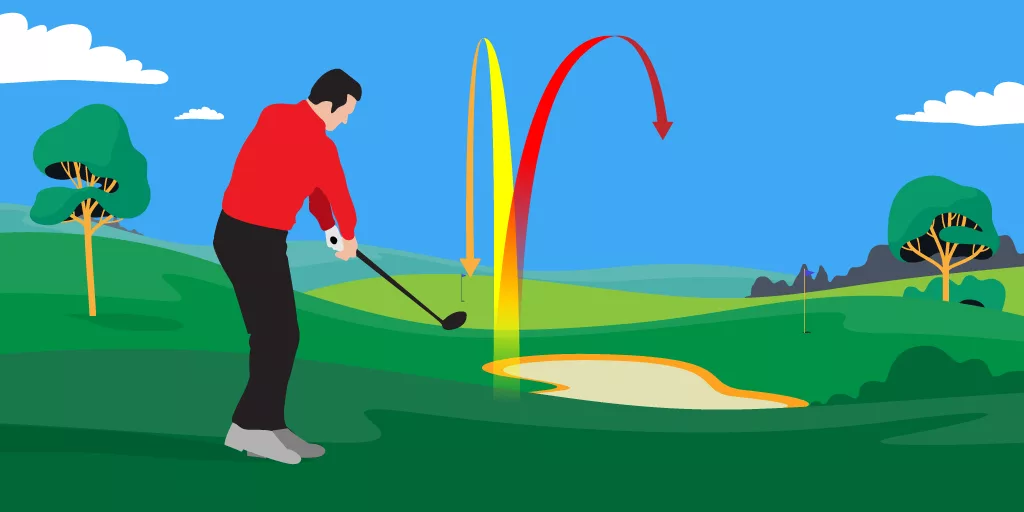
A slice is a common golf shot that curves significantly from left to right (for right-handed golfers) or from right to left (for left-handed golfers). This ball flight pattern is particularly prevalent and frustrating among amateur golfers, as it can lead to missed fairways, lost balls, and higher scores. If you've ever asked yourself, "Why do I slice my driver?" you're not alone. This article'll explore the common causes of slicing a driver and provide practical solutions to help you straighten your shots and enjoy more success on the golf course.
Common Causes of Slicing a Driver
Incorrect Grip
How you grip your golf club is crucial in controlling the clubface throughout the swing. An incorrect grip, particularly a weak grip, can cause issues with your clubface position at impact. A weak grip is characterized by having the "V" shapes formed by your thumb and index finger pointing more toward your trail shoulder (right shoulder for right-handed golfers). This grip position often leads to an open clubface at impact, which causes the ball to start right of the target and curve further right, resulting in a slice.
Poor Alignment
Proper alignment is essential for producing the desired ball flight, affecting the path your clubhead takes during the swing. Many golfers who struggle with a slice unknowingly align themselves too far left of the target (for right-handed golfers), creating a setup that promotes an out-to-in swing path. This swing path encourages the clubface to be open relative to the path at impact, causing the ball to curve from left to right and producing a slice. Ensuring proper alignment can help alleviate this issue and promote a more neutral swing path.
Improper Swing Path
Swing path refers to the direction your clubhead travels during the swing relative to the target line. There are two main types of swing paths: "inside-out" and "outside-in." An inside-out swing path occurs when the clubhead approaches the ball from the inside of the target line and moves outward after impact. Conversely, an outside-in swing path happens when the clubhead approaches the ball from outside the target line and moves inward after impact. Slicing is commonly associated with an outside-in swing path, as it causes the clubface to be open relative to the path at impact, leading to a left-to-right curve (for right-handed golfers).
Swing Plane Issues
The swing plane is the angle at which your clubhead travels around your body during the swing. An ideal swing plane promotes consistent contact and optimal ball flight. However, an incorrect swing plane can contribute to slicing. For instance, a swing plane that is too steep (too vertical) or too flat (too horizontal) can make it difficult to square the clubface at impact, resulting in a slice. By addressing swing plane issues, you can improve your clubface control and reduce the likelihood of slicing your driver.
Clubface Position at Impact
The position of your clubface at the critical moment of impact significantly influences the ball's flight. If your clubface is square (aligned with the target) at impact, you will likely produce a straight shot. However, if the clubface is open (pointing right of the target for right-handed golfers) at impact, the ball will start to the right and curve even further right, resulting in a slice.
An open clubface at impact is often the primary cause of slicing the driver. By addressing the various factors contributing to an open clubface, such as grip, alignment, swing path, and swing plane, you can work towards squaring the clubface at impact and eliminating the dreaded slice from your game.
The Role of Equipment in Slicing
Believe it or not, your equipment can also contribute to slicing. An ill-fitting driver or an incorrect shaft flex can exacerbate swing flaws, making it more difficult to square the clubface at impact. For instance, a driver with too much loft or a too stiff shaft can cause the clubface to remain open at impact, leading to a slice. To minimize the impact of equipment on your slice, consider consulting with a golf professional or club fitter to ensure you have the right driver and shaft for your swing.
Conclusion
In conclusion, slicing a driver is a common issue many recreational golfers face. By understanding the common causes of slicing, such as incorrect grip, poor alignment, improper swing path, swing plane issues, and an open clubface at impact, you can address these issues and improve your ball flight. Remember that equipment also plays a role in slicing, so make sure your driver and shaft are well-suited for your swing. With practice and dedication, you can make the necessary adjustments to reduce and eventually eliminate slicing from your game. Embrace the challenge and enjoy the journey towards a straighter and more consistent drive.
Frequently Asked Questions
Discover brief answers to common questions related to slicing your driver, aiding you in improving your golf game.